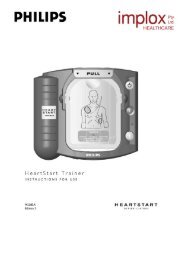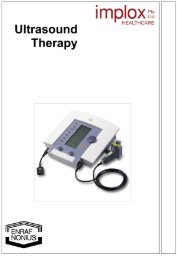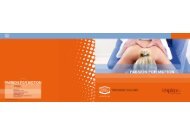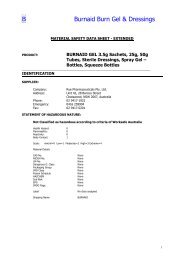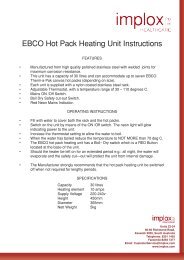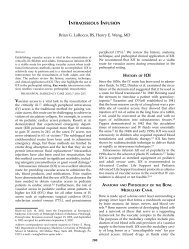Low and medium Frequency Electrotherapy - Implox
Low and medium Frequency Electrotherapy - Implox
Low and medium Frequency Electrotherapy - Implox
You also want an ePaper? Increase the reach of your titles
YUMPU automatically turns print PDFs into web optimized ePapers that Google loves.
7 IONTOPHORESIS<br />
7.1 Introduction<br />
Iontophoresis therapy is a very specific application of direct current. The therapy is, in fact, a form of medication using<br />
substances that can be introduced into the body as charged particles (ions) by a direct electric current. The<br />
medication is almost invariably in the form of an aqueous solution but, in a few cases, a gel may be used. An<br />
advantage of this form of therapy is that the medication can be introduced locally, without having to take account of<br />
the ‘first pass’ effect.<br />
The therapy consists of applying the electrodes over the region to be treated, taking due notice of the polarity of both<br />
the medication <strong>and</strong> the electrode. Positive ions, which move towards the cathode, are referred to as actions.<br />
Substances with a preponderance of actions should therefore be applied under the anode (+). Negative ions, which<br />
move towards the anode, are referred to as anions. Substances with a preponderance of anions should therefore be<br />
applied under the cathode (-)*.<br />
To date, iontophoresis is virtually exclusively applied using direct current (galvanic current).<br />
When direct current is interrupted at a frequency of 8000 Hz, a new type of current is created: the <strong>medium</strong>-frequency<br />
direct current. At a phase interval of 5 µs <strong>and</strong> a phase duration of 125 µs, the duty cycle is 95%, resulting in a current<br />
which for most practical purposes is identical to a galvanic current. However, there is one major difference: the<br />
<strong>medium</strong> frequency of this current makes it ‘patient friendly’ (5, 18) . If patients are treated with both current types in<br />
succession (galvanic current <strong>and</strong> <strong>medium</strong>-frequency direct current) there is no observable difference in the effects.<br />
However, the patients report that the <strong>medium</strong>-frequency direct current is much more easily tolerated.<br />
* The responsibility for deciding on the medication to be introduced lies with the physician. The physiotherapist has<br />
a reporting function, <strong>and</strong> should be aware of any side effects or interactions.<br />
7.2 Medication <strong>and</strong> safety<br />
The effect of iontophoresis therapy depends on the medications to be introduced. Due to the wide diversity of<br />
available medication, the possible applications are very extensive.<br />
When medication is applied it is essential that the therapist should be fully informed of the effects <strong>and</strong> possible side<br />
effects of the medication to be used before treatment begins. The indications <strong>and</strong> contra-indications for each<br />
substance should also be known. These are beyond the scope of this book.<br />
However, with respect to the application of the current, there are some rules which should be taken into account:<br />
• the active electrode (different electrode must have a relatively small area;<br />
• the area of the indifferent electrode must always be greater than that of the active electrode. The indifferent<br />
electrode should preferably be positioned diametrically opposite the active electrode;<br />
• the electrode surface must make good contact with the body surface, to prevent the occurrence of point effects;<br />
• it is recommended that the maximum current density at the active electrode should not exceed 0.2 mA/cm²<br />
The dosage of the medication to be introduced should also be taken into account. It is virtually impossible to<br />
determine the exact quantity of the medication introduced.<br />
However, it is possible to calculate the maximum possible quantity by means of the following formula:<br />
m =<br />
I.t.M<br />
n<br />
x<br />
1<br />
9,6.10 4<br />
m = mass of substance introduced (kg)<br />
l = current amplitude (A)<br />
t = duration of current flow (s)<br />
M = molar mass (kg/mol)<br />
n = valency of substance introduced<br />
1<br />
9,6.10 4 = a constant<br />
The quantity of medication actually introduced will be somewhat lower than this value. The reason for this is that<br />
there are always parasitic ions present on the skin which are also transported into the skin.<br />
33





